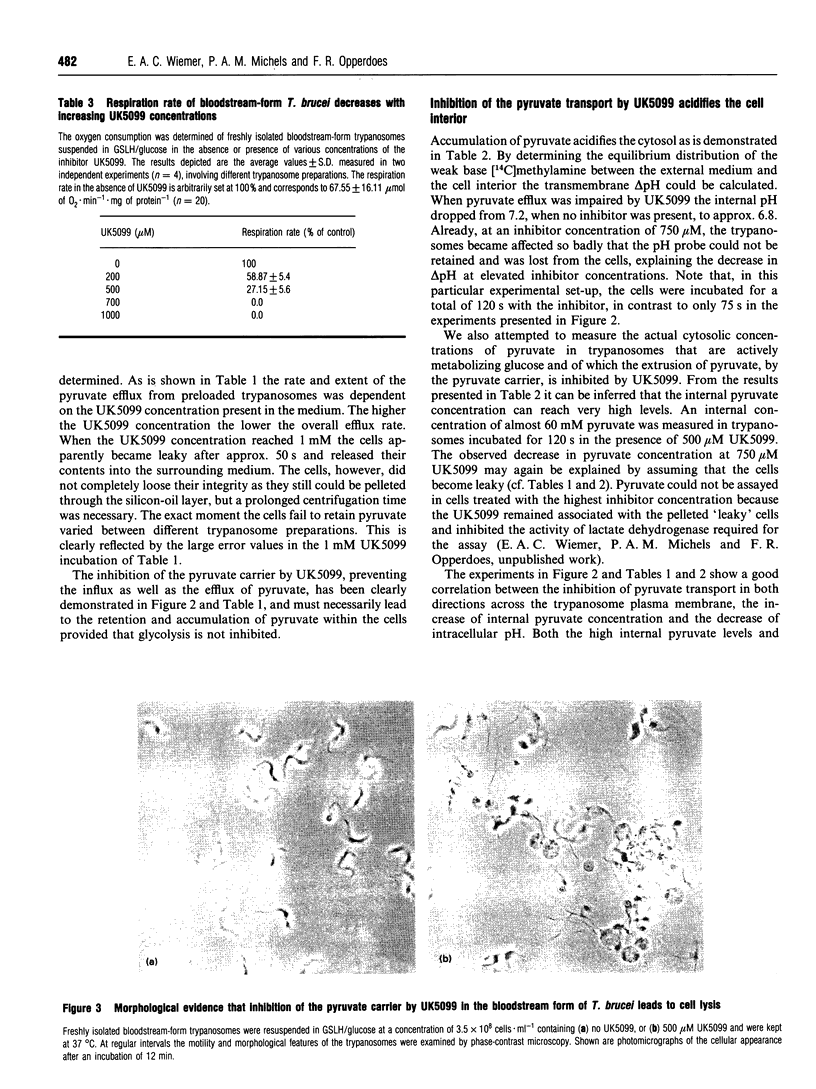Abstract
The pyruvate produced by glycolysis in the bloodstream form of the trypanosome is excreted into the host bloodstream by a facilitated diffusion carrier. The sensitivity of pyruvate transport for alpha-cyano-4-hydroxycinnamate and the compound UK5099 [alpha-cyano-beta-(1-phenylindol-3-yl)acrylate], which are known to be selective inhibitors of pyruvate (monocarboxylate) transporters present in mitochondria and the plasma membrane of eukaryotic cells, was examined. The trypanosomal pyruvate carrier was found to be rather insensitive to inhibition by alpha-cyano-4-hydroxycinnamate (Ki = 17 mM) but could be completely blocked by UK5099 (Ki = 49 microM). Inhibition of pyruvate transport resulted in the retention, and concomitant accumulation, of pyruvate within the trypanosomes, causing acidification of the cytosol and osmotic destabilization of the cells. Our results indicate that this physiological state has serious metabolic consequences and ultimately leads to cell death; thereby identifying the pyruvate carrier as a possible target for chemotherapeutic intervention.
Full text
PDF





Images in this article
Selected References
These references are in PubMed. This may not be the complete list of references from this article.
- Barnard J. P., Reynafarje B., Pedersen P. L. Glucose catabolism in African trypanosomes. Evidence that the terminal step is catalyzed by a pyruvate transporter capable of facilitating uptake of toxic analogs. J Biol Chem. 1993 Feb 15;268(5):3654–3661. [PubMed] [Google Scholar]
- Bolli R., Nałecz K. A., Azzi A. Monocarboxylate and alpha-ketoglutarate carriers from bovine heart mitochondria. Purification by affinity chromatography on immobilized 2-cyano-4-hydroxycinnamate. J Biol Chem. 1989 Oct 25;264(30):18024–18030. [PubMed] [Google Scholar]
- Coppens I., Opperdoes F. R., Courtoy P. J., Baudhuin P. Receptor-mediated endocytosis in the bloodstream form of Trypanosoma brucei. J Protozool. 1987 Nov;34(4):465–473. doi: 10.1111/j.1550-7408.1987.tb03216.x. [DOI] [PubMed] [Google Scholar]
- Denton R. M., Halestrap A. P. Regulation of pyruvate metabolism in mammalian tissues. Essays Biochem. 1979;15:37–77. [PubMed] [Google Scholar]
- Halestrap A. P., Denton R. M. Specific inhibition of pyruvate transport in rat liver mitochondria and human erythrocytes by alpha-cyano-4-hydroxycinnamate. Biochem J. 1974 Feb;138(2):313–316. doi: 10.1042/bj1380313. [DOI] [PMC free article] [PubMed] [Google Scholar]
- Halestrap A. P., Denton R. M. The specificity and metabolic implications of the inhibition of pyruvate transport in isolated mitochondria and intact tissue preparations by alpha-Cyano-4-hydroxycinnamate and related compounds. Biochem J. 1975 Apr;148(1):97–106. doi: 10.1042/bj1480097. [DOI] [PMC free article] [PubMed] [Google Scholar]
- Halestrap A. P., Poole R. C., Cranmer S. L. Mechanisms and regulation of lactate, pyruvate and ketone body transport across the plasma membrane of mammalian cells and their metabolic consequences. Biochem Soc Trans. 1990 Dec;18(6):1132–1135. doi: 10.1042/bst0181132. [DOI] [PubMed] [Google Scholar]
- Halestrap A. P. Pyruvate and ketone-body transport across the mitochondrial membrane. Exchange properties, pH-dependence and mechanism of the carrier. Biochem J. 1978 Jun 15;172(3):377–387. doi: 10.1042/bj1720377. [DOI] [PMC free article] [PubMed] [Google Scholar]
- Halestrap A. P. The mechanism of the inhibition of the mitochondrial pyruvate transportater by alpha-cyanocinnamate derivatives. Biochem J. 1976 Apr 15;156(1):181–183. doi: 10.1042/bj1560181. [DOI] [PMC free article] [PubMed] [Google Scholar]
- Halestrap A. P. The mitochondrial pyruvate carrier. Kinetics and specificity for substrates and inhibitors. Biochem J. 1975 Apr;148(1):85–96. doi: 10.1042/bj1480085. [DOI] [PMC free article] [PubMed] [Google Scholar]
- Konings W. N., Poolman B., Driessen A. J. Bioenergetics and solute transport in lactococci. Crit Rev Microbiol. 1989;16(6):419–476. doi: 10.3109/10408418909104474. [DOI] [PubMed] [Google Scholar]
- LaNoue K. F., Schoolwerth A. C. Metabolite transport in mitochondria. Annu Rev Biochem. 1979;48:871–922. doi: 10.1146/annurev.bi.48.070179.004255. [DOI] [PubMed] [Google Scholar]
- Lanham S. M., Godfrey D. G. Isolation of salivarian trypanosomes from man and other mammals using DEAE-cellulose. Exp Parasitol. 1970 Dec;28(3):521–534. doi: 10.1016/0014-4894(70)90120-7. [DOI] [PubMed] [Google Scholar]
- Nałecz K. A., Bolli R., Wojtczak L., Azzi A. The monocarboxylate carrier from bovine heart mitochondria: partial purification and its substrate-transporting properties in a reconstituted system. Biochim Biophys Acta. 1986 Aug 13;851(1):29–37. doi: 10.1016/0005-2728(86)90245-8. [DOI] [PubMed] [Google Scholar]
- Opperdoes F. R., Borst P., Fonck K. The potential use of inhibitors of glycerol-3-phosphate oxidase for chemotherapy of African trypanosomiasis. FEBS Lett. 1976 Feb 15;62(2):169–172. doi: 10.1016/0014-5793(76)80045-2. [DOI] [PubMed] [Google Scholar]
- Opperdoes F. R., Borst P. Localization of nine glycolytic enzymes in a microbody-like organelle in Trypanosoma brucei: the glycosome. FEBS Lett. 1977 Aug 15;80(2):360–364. doi: 10.1016/0014-5793(77)80476-6. [DOI] [PubMed] [Google Scholar]
- Opperdoes F. R. Compartmentation of carbohydrate metabolism in trypanosomes. Annu Rev Microbiol. 1987;41:127–151. doi: 10.1146/annurev.mi.41.100187.001015. [DOI] [PubMed] [Google Scholar]
- Poole R. C., Halestrap A. P. Transport of lactate and other monocarboxylates across mammalian plasma membranes. Am J Physiol. 1993 Apr;264(4 Pt 1):C761–C782. doi: 10.1152/ajpcell.1993.264.4.C761. [DOI] [PubMed] [Google Scholar]
- Rottenberg H. The measurement of membrane potential and deltapH in cells, organelles, and vesicles. Methods Enzymol. 1979;55:547–569. doi: 10.1016/0076-6879(79)55066-6. [DOI] [PubMed] [Google Scholar]
- Ter Kuile B. H., Opperdoes F. R. Glucose uptake by Trypanosoma brucei. Rate-limiting steps in glycolysis and regulation of the glycolytic flux. J Biol Chem. 1991 Jan 15;266(2):857–862. [PubMed] [Google Scholar]
- Visser N., Opperdoes F. R., Borst P. Subcellular compartmentation of glycolytic intermediates in Trypanosoma brucei. Eur J Biochem. 1981 Sep 1;118(3):521–526. doi: 10.1111/j.1432-1033.1981.tb05550.x. [DOI] [PubMed] [Google Scholar]
- Visser N., Opperdoes F. R. Glycolysis in Trypanosoma brucei. Eur J Biochem. 1980 Feb;103(3):623–632. doi: 10.1111/j.1432-1033.1980.tb05988.x. [DOI] [PubMed] [Google Scholar]
- Wiemer E. A., Ter Kuile B. H., Michels P. A., Opperdoes F. R. Pyruvate transport across the plasma membrane of the bloodstream form of Trypanosoma brucei is mediated by a facilitated diffusion carrier. Biochem Biophys Res Commun. 1992 Apr 30;184(2):1028–1034. doi: 10.1016/0006-291x(92)90694-g. [DOI] [PubMed] [Google Scholar]



